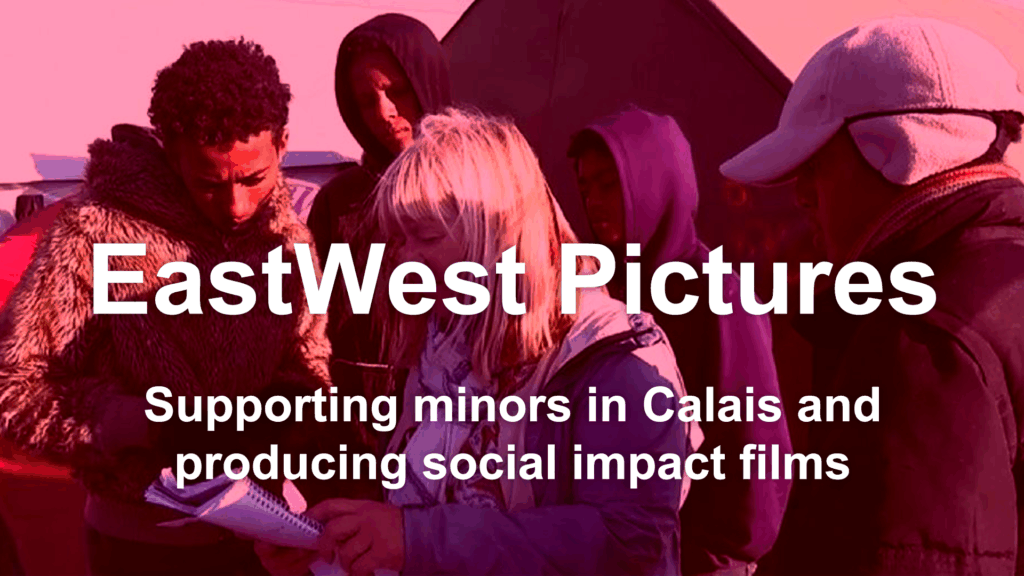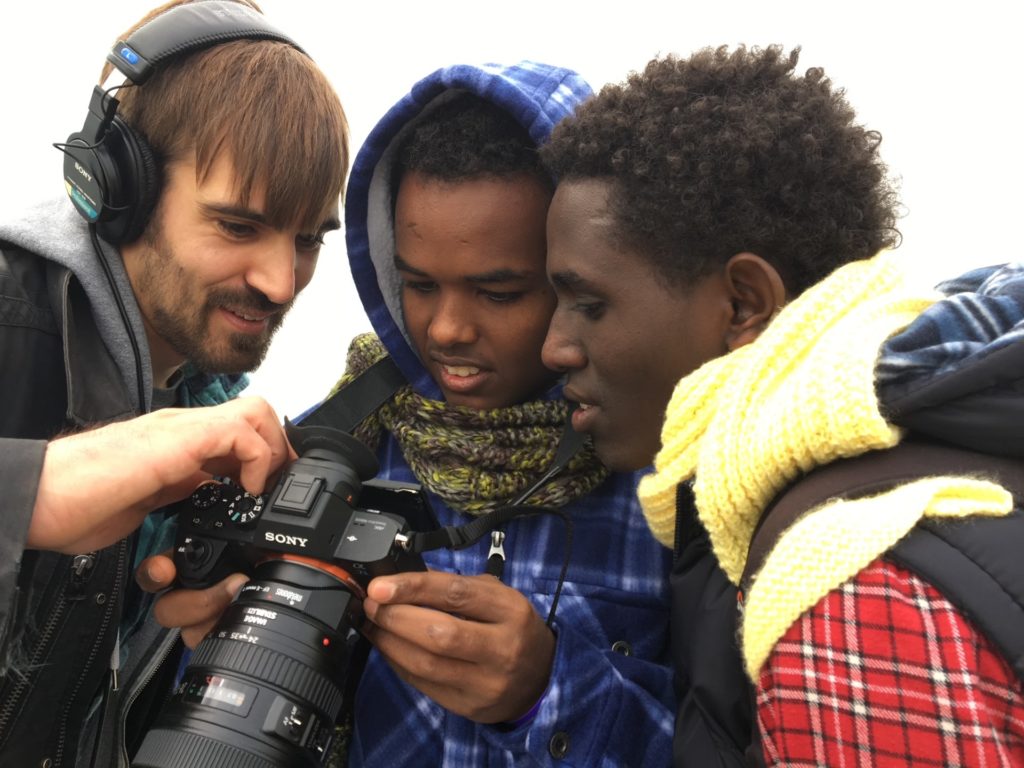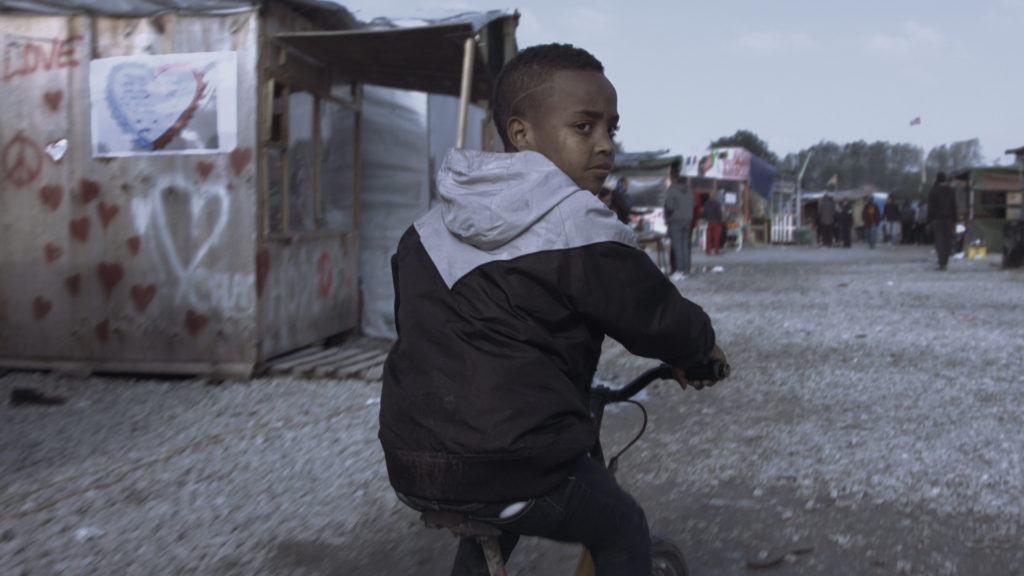
About EastWest Pictures
Eastwest Pictures has worked for 13 years to support asylum seekers abandoned in Europe, particularly unaccompanied minors, and those who aid them, according to Prof Sue Clayton, the project’s founder.
About the project
Eastwest Picture Fund develops innovative participatory approaches to filming and evidence-gathering with asylum seekers, to help better present their case to the public, and in law. It also aims to explore where there may still be symptomatic gaps in communication and representation, and address these
Project context
Eastwest has produced three films (Calais Children: A Case to Answer; Hamedullah: the Road Home; The Stansted 15: On Trial) a play (Mazloom) and many Channel 4 News items, about asylum seekers in their countries of origin, on their journeys here and in their new settlements. These works have all involved participatory practices in relation to the voices and concerns of such groups.
In addition, as finished works they have all involved extensive engagement and discussion, both in communities and in the courts, around how we ‘read’ such evidence and testimonies, and what we may still be missing. Hamedullah has screened at over 250 venues both nationally and internationally, and Calais Children at over 500. Often the film participants have attended and spoken at such screenings, and brought further reflection and engagement. Both films have been requested as evidence by the Immigration courts to support individual appeals, and the Calais film by the Court of Appeal in a Judicial Review (ZS and Others, 2019).
Goals
To add further elements to its existing participatory practice in two ways:
1. To self-critically examine the process of consent, especially among vulnerable people and those under the age of 18. To consider ways to renegotiate subjects’ engagement to maximise their choices and amplify their voice, while still providing protection from any adverse consequences of media exposure.
2. To explore inherent themes that occur in our transactions and our filming with asylum seekers, that might suggest there are experiences, attitudes or approaches in the subject group that we are perhaps still failing to fully see or respond to.

Participatory considerations and practices
In terms of participation, questions of safeguarding have become more pressing as material is captured and shared by audiences using online platforms, with their attendant risk of negative responses and even direct harm for those featured. For instance, in the making of Calais Children, many of the young people left in limbo in Calais wanted to express their frustrations with the UK immigration system, but the project team had to ensure that their actions and views would not prejudice their claim if the Home Office were alerted to them, and also consider if their statements about in-country danger might cause risk to family members back home if the film reached those territories. It is always a challenging balance to strike, says Clayton, while at the same striving not to ‘control’ or ‘patronise’ young people whose extreme circumstances drive them to push the boundaries of expression.
The project team has worked extensively on participatory ethics, for example supervising the Inclusion Through Art report and guidelines (Lockowandt, 2013) and designing what is described as a ‘Graded Consent Form’ (GCF) for arts and media participants, where the traditional consent form used by media companies and non-governmental organisations (NGOs) is replaced by a document requiring more nuanced engagement in several ways:
- The GCF is not only about participant consent: it also requires the creative body seeking consent to fully detail their own position, aims and concerns; how and where they intend to show the work and to what end; and how any future remunerations will be used or shared.
- Crucially the GCF lists gradations of participation: a young person may specify: “You must use a different first name that is not actually mine,” or “You may say the region I’m from, but not the actual town.” And in representational terms for instance: “We can show the back of my body but not my face.” Completing the GCF should be done as part of a wider discussion as around what different modes of participation involve, and what could be their consequences.
Clayton recommends on the form that the above discussion process takes place in a recorded format, so that the wishes and views of the subject(s) can be reviewed in the future, and terms of their participation given in full context.
Project outcomes
Versions of the GCF have been adopted as good practice by organisations like One World Media and other forums where Sue Clayton has spoken on this topic, and created a helpful tool in this field – one which she recommends is employed early in the collaborative process, and not as a kind of extractive “signing off.” Clayton has also been able to introduce some of its elements into the standard consent forms used by Channel 4 News – for instance, coming up with extra forms of protection for those who fall under the terms of the Modern Slavery Act and who may be subject to violence and threats from UK employers.
In addition, the project team has also used semiotic and thematic analysis, alongside psychoanalytic methodological approaches, to explore participants’ contributions. In a co-authored book drawing from interview material assembled since 2024, Clayton recorded participants’ negotiations with her project team (Clayton et al. 2019).
One Afghan interviewee described how one of his friends had abandoned so-called ‘legal’ routes into the UK. “They said they’d take him – but they’re just playing with them. They promise but they don’t do.” These were E’s final words as he and his friends walked off. Any representation of ‘journeys’ is bound to be full of shots of people travelling and moving. But I found increasingly I was filming people walking away from, and not towards, the camera. They had pride enough to talk and engage, but also anger, and pride, enough to walk away” (Clayton, 2019).
“E and his friends felt abandoned, angry, unheard, confused but also still doggedly resilient. To some extent they took out the anger on well-meaning volunteers and film-makers like us, while at the same time on other days wanting and demanding our care. It is important to understand all these deep dynamics, upon which the more transactional issues of ‘participation’ rest” (Clayton, 2019)

Looking to the future
A further project of Eastwest is looking at the fact that around 2 million electors can no longer exercise their democratic right to vote, as they do not have the very restricted forms of Photo ID now required. This includes many from migrant backgrounds and other marginalised groups such as those on low income, the neurodiverse, people with disabilities and trans people.
Clayton says “I and the Eastwest project team are applying our participatory practices and methodologies to work with the Electoral Commission and with over 20 grassroots advocacy groups, to fully critique the provisions of the last Act, and work with the current government on recommendations for voting at local and national level to be fully inclusive, and not render migrants and others invisible in this key democratic process.”
Learn more
References
Clayton. S (2019) ‘Narrating the Young Migrant Journey: Themes of Self-Representation’ in Clayton, S , Gupta, A and Willis, K (ed), Unaccompanied Young Migrants: Identity , Care and Justice Bristol: Policy Press.
Lockowandt, M (2013) Inclusion Through Art: An Organisational Guideline to Using the Participatory Arts with Young Refugees and Asylum Seekers. London: Refugee Support Network.